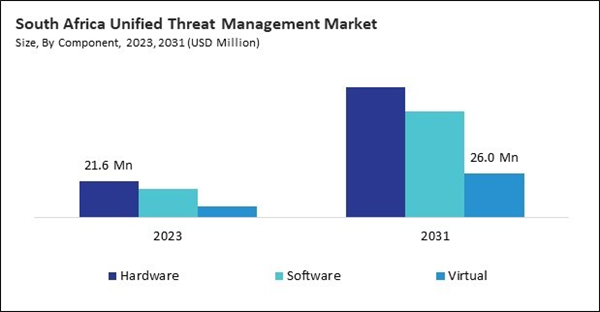The Latin America, Middle East and Africa Unified Threat Management Market is expected to witness market growth of 17.4% CAGR during the forecast period (2024-2031).
The Brazil market dominated the LAMEA Unified Threat Management Market by Country in 2023, and is expected to continue to be a dominant market till 2031; thereby, achieving a market value of $348.5 million by 2031. The Argentina market is showcasing a CAGR of 18.9% during 2024-2031. Additionally, the UAE market would register a CAGR of 16.2% during 2024-2031.
digital transformation initiatives have been a significant factor in the market's expansion across a variety of industries. According to the World Bank’s Digital Progress and Trends Report 2023, in 2022, more than 13 billion IoT devices were in use. Driven largely by the almost real-time connectivity of 5G technology, these devices are expected to more than double between 2023 and 2028.
Additionally, as companies integrate advanced technologies like cloud computing, the Internet of Things (IoT), and artificial intelligence (AI) into their operations, protecting the resulting digital ecosystems has become more urgent. UTM solutions are vital in securing these devices by providing robust network monitoring and access control, ensuring that IoT deployments do not become entry points for malicious actors
The LAMEA region’s market reflects diverse drivers, from the growing digitalization of retail sectors to the adoption of smart manufacturing technologies. In order to safeguard consumer data from cyberattacks and ensure the security of online transactions, Brazil's retailers are under constant pressure. According to the International Trade Administration, Brazil's e-commerce sector is expected to exceed US$200 billion by 2026.
The growth of digital payment methods and online shopping platforms has expanded the attack surface, making data breaches a critical concern. UTM solutions have become an integral part of the cybersecurity strategy for Brazilian retailers, offering integrated features such as secure web gateways and real-time threat monitoring to safeguard digital transactions.
The Brazil market dominated the LAMEA Unified Threat Management Market by Country in 2023, and is expected to continue to be a dominant market till 2031; thereby, achieving a market value of $348.5 million by 2031. The Argentina market is showcasing a CAGR of 18.9% during 2024-2031. Additionally, the UAE market would register a CAGR of 16.2% during 2024-2031.
digital transformation initiatives have been a significant factor in the market's expansion across a variety of industries. According to the World Bank’s Digital Progress and Trends Report 2023, in 2022, more than 13 billion IoT devices were in use. Driven largely by the almost real-time connectivity of 5G technology, these devices are expected to more than double between 2023 and 2028.
Additionally, as companies integrate advanced technologies like cloud computing, the Internet of Things (IoT), and artificial intelligence (AI) into their operations, protecting the resulting digital ecosystems has become more urgent. UTM solutions are vital in securing these devices by providing robust network monitoring and access control, ensuring that IoT deployments do not become entry points for malicious actors
The LAMEA region’s market reflects diverse drivers, from the growing digitalization of retail sectors to the adoption of smart manufacturing technologies. In order to safeguard consumer data from cyberattacks and ensure the security of online transactions, Brazil's retailers are under constant pressure. According to the International Trade Administration, Brazil's e-commerce sector is expected to exceed US$200 billion by 2026.
The growth of digital payment methods and online shopping platforms has expanded the attack surface, making data breaches a critical concern. UTM solutions have become an integral part of the cybersecurity strategy for Brazilian retailers, offering integrated features such as secure web gateways and real-time threat monitoring to safeguard digital transactions.
List of Key Companies Profiled
- Check Point Software Technologies Ltd.
- IBM Corporation
- Fortinet, Inc.
- Sophos Group PLC (Thoma Bravo)
- Barracuda Networks, Inc. (KKR & Co. Inc.)
- Trend Micro, Inc.
- Cisco Systems, Inc.
- Huawei Technologies Co., Ltd. (Huawei Investment & Holding Co., Ltd.)
- Juniper Networks, Inc.
- Sonicwall, Inc.
Market Report Segmentation
By Deployment
- Cloud
- On-premise
By Enterprise Size
- SMEs
- Large Enterprise
By End Use
- BFSI
- Government
- Healthcare
- Manufacturing
- Retail
- Telecom & IT
- Other End Use
By Component
- Hardware
- Software
- Virtual
By Country
- Brazil
- Argentina
- UAE
- Saudi Arabia
- South Africa
- Nigeria
- Rest of LAMEA
Table of Contents
Chapter 1. Market Scope & Methodology
Chapter 2. Market at a Glance
Chapter 3. Market Overview
Chapter 4. Competition Analysis - Global
Chapter 5. LAMEA Unified Threat Management Market by Deployment
Chapter 6. LAMEA Unified Threat Management Market by Enterprise Size
Chapter 7. LAMEA Unified Threat Management Market by End Use
Chapter 8. LAMEA Unified Threat Management Market by Component
Chapter 9. LAMEA Unified Threat Management Market by Country
Chapter 10. Company Profiles
Companies Mentioned
- Check Point Software Technologies Ltd.
- IBM Corporation
- Fortinet, Inc.
- Sophos Group PLC (Thoma Bravo)
- Barracuda Networks, Inc. (KKR & Co. Inc.)
- Trend Micro, Inc.
- Cisco Systems, Inc.
- Huawei Technologies Co., Ltd. (Huawei Investment & Holding Co., Ltd.)
- Juniper Networks, Inc.
- Sonicwall, Inc.
Methodology

LOADING...









